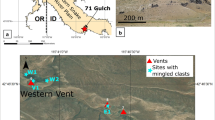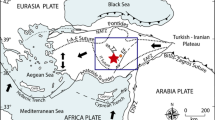Abstract
Lithic megablocks ranging from <1 to 50 m in diameter occur in the Yardea Dacite, a widespread (12,000 km2), thick (>200 m) felsic volcanic unit in the Mesoproterozoic Gawler Range Volcanic Province (GRV) of South Australia. Throughout its vast extent, the Yardea Dacite shows typical lava-like features, in that it is massive, columnar jointed and evenly porphyritic with 30–40% crystals in a spherulitic and granophyric groundmass. In addition, flow banding is present at many locations. The megablocks are abundant at two sites 50 km apart, but isolated megablocks and smaller (<6 cm) lithic clasts are also scattered throughout the unit. At both sites the megablocks are matrix supported, non-graded, randomly oriented and show no evidence of being confined to a particular stratigraphic level in the dacite. The most abundant and largest megablocks are granitoids derived from older basement and from early-crystallised plutons of the Hiltaba Suite, which is broadly coeval and comagmatic with the GRV. The granitoid megablocks have been partially melted, most likely prior to eruption when resident in the thermal aureole of the Yardea Dacite magma chamber. The lithic megablock occurrences are unlike coarse pyroclastic breccias but are similar in distribution and abundance to xenoliths in lavas, consistent with the lava-like character of the host dacite. Using reasonable estimates of megablock density, magma density and magma viscosity, we show that the rise rate of the dacitic magma exceeded the settling velocity of the megablocks, implying that they could have been entrained and erupted effusively. All but the largest and least-melted megablocks would have remained suspended or else settled very slowly in the dacitic lava during outflow. The rapid rate of magma withdrawal required to produce such an extensive felsic sheet could have also triggered disintegration of the thermally stressed wallrock surrounding the magma chamber, dislodging megablocks that were later entrained and effusively erupted.
Similar content being viewed by others
Author information
Authors and Affiliations
Additional information
Received: 11 November 1998 / Accepted: 18 April 1999
Rights and permissions
About this article
Cite this article
Garner, A., McPhie, J. Partially melted lithic megablocks in the Yardea Dacite, Gawler Range Volcanics, Australia: implications for eruption and emplacement mechanisms. Bull Volcanol 61, 396–410 (1999). https://doi.org/10.1007/s004450050281
Issue Date:
DOI: https://doi.org/10.1007/s004450050281




